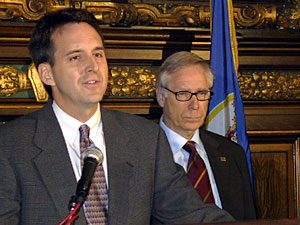Photos
More from MPR
Your Voice
| |||||||||||||||||||||||||||||||||||||||||||||||
Mayo, U of M forge bioscience alliance
April 17, 2003
 |
| Gov. Tim Pawlenty and University of Minnesota President Robert Bruininks announce an alliance for bioscience research. (MPR Photo/Laura McCallum) |
St. Paul, Minn. — Officials from the state, the University of Minnesota and the Mayo Clinic have been meeting for months to discuss a bioscience partnership. Now, they've formalized the arrangement, and put some dollars on the table. The state's two leading medical research institutions will work together, instead of competing for research dollars.
"Mayo and the university will be locking arms and competing with all others on this," says Dr. Hugh Smith, who chairs the Mayo Clinic board.
Smith says more than 40 states are investing in bioscience development. But Smith says Minnesota is ahead of many of them, because both Mayo and the U have a track record of research successes.
"We are really not at the starting gate. We are well down the track. The university has made significant investment, Mayo has made significant investment. So we already have our feet on the ground and running," says Smith.
|
We cannot be mired down in the budget crisis to the point where we can't move forward with something that's this important.
- Gov. Tim Pawlenty |
Among the other states investing in bioscience are Wisconsin, which has dedicated more than $300 million to a biotech development fund, and Michigan, which has a $1 billion initiative.
Minnesota's investment isn't quite on that scale. The state, Mayo and the university plan to contribute a total of $4 million in seed money to start the project. Gov. Pawlenty says the state would also contribute $70 million over the next five years to help pay for faculty and equipment, and borrow for a $30 million research center to be built in Rochester.
"We cannot be mired down in the budget crisis to the point where we can't move forward with something that's this important," Pawlenty says. "This has profound implications for the future quality of life for Minnesotans and our economy."
Pawlenty says the partnership between the U and Mayo is the cornerstone of a larger biotech initiative. It includes a summit in Minneapolis next month, and a proposal for a bioscience park somewhere in Minnesota -- a bill that's moving through the Legislature. But with the state facing a projected $4.2 billion deficit, Gov. Pawlenty says he hasn't figured out yet where the bioscience money will come from.
DFL leaders say that's the problem with Pawlenty's budget. Senate Majority Leader John Hottinger of St. Peter says Pawlenty's no-tax-increase pledge means that there's no room in the budget for something that both he and the governor support.
"And I hope this would loosen the governor to listening to the reality that it's good for Minnesota to get some additional money, to make these very important investments for our economy," Hottinger says.
Hottinger says the governor's budget would also make significant cuts to the University of Minnesota. University president Robert Bruininks says even as the U makes budget cuts, it will invest in bioscience research.
"If you don't continue to invest, and you don't keep the state on the cutting edge, you're going to actually decline," Bruininks says. "In a global economy, where intellectual capital, where the development of ideas, will propel the economy of the future, you can't simply stand still. You have to invest at the same time."
Bruininks says the partnership will create at least 150 new research jobs. At one point in the partnership discussions, the plan was to build two biotech centers -- one at the university, one at the Mayo Clinic. Mayo officials say the decision was made to build one facility in Rochester, where research space is limited. They'll try to include the project in next year's bonding bill.
|
News Headlines
|
Related Subjects
|

